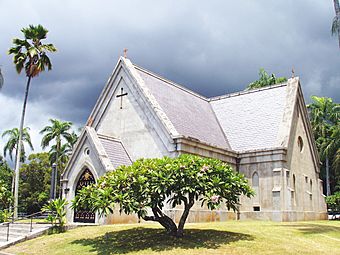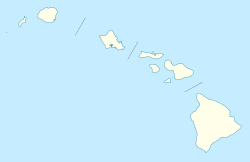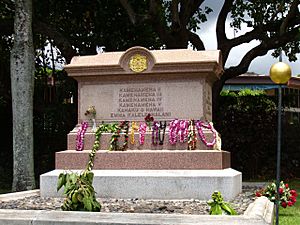Royal Mausoleum (Mauna ʻAla) facts for kids
Quick facts for kids |
|
|
Royal Mausoleum
|
|

The main building is now a chapel
|
|
| Location | 2261 Nuʻuanu Ave., Honolulu, Hawaii |
|---|---|
| Area | 4 acres (1.6 ha) |
| Built | 1863 |
| Architect | Theodore C. Heuck |
| Architectural style | Gothic |
| NRHP reference No. | 72000422 |
| Added to NRHP | August 7, 1972 |
Mauna ʻAla, which means "Fragrant Hills" in the Hawaiian language, is also known as the Royal Mausoleum of Hawaii. It is a very special place where two important royal families of Hawaii are buried. These are the Kamehameha Dynasty and the Kalākaua Dynasty. It is a peaceful and historic site.
Contents
History of the Royal Burial Ground
In the early 1800s, there was an old burial area called Pohukaina. People believed it was named after a chief who chose a cave for his final resting place. This land belonged to Kekauluohi, who later became a powerful leader called Kuhina Nui.
After 1825, the first royal tomb in a Western style was built. It was for King Kamehameha II and his queen, Kamāmalu. They were buried there on August 23, 1825. This idea came from the tombs at Westminster Abbey in London, which King Kamehameha II had seen.
The first mausoleum was a small house made of coral blocks. It had a thatched roof and no windows. Two chiefs guarded its locked door day and night. Only for burials or on Memorial Day (December 30) could anyone enter. As more people were buried, the small tomb became too full. Other chiefs were buried in unmarked graves nearby.
In 1865, twenty coffins were moved to a new Royal Mausoleum called Mauna ʻAla. This new site was in Nuʻuanu Valley. However, many chiefs, like Keaweʻīkekahialiʻiokamoku and Kalaniopuu, still rest at the old site.
Building the Mausoleum
The Royal Mausoleum covers about 2.7 acres (11,000 square meters). It was designed by an architect named Theodore Heuck. King Kamehameha IV and Queen Emma planned it as a burial place for their family.
Sadly, the first person buried there was their four-year-old son, Prince Albert. He passed away on August 27, 1862. King Kamehameha IV became ill soon after and died on November 30, 1863. This was just 15 months after his son. His brother, Lot Kamehameha, then became King Kamehameha V.
King Kamehameha V quickly started building the mausoleum. Bishop Thomas Nettleship Staley helped oversee the construction. The first part of the building was finished in January 1864. On February 3, 1864, a large funeral procession brought King Kamehameha IV's body from ʻIolani Palace. His casket was placed in the new building. Later, Prince Albert's casket was laid beside his father. Queen Emma was so sad that she stayed at Mauna ʻAla and slept in the mausoleum.
The mausoleum was completed in 1865. It was built next to the public Oahu Cemetery. It seemed like a good place to bury other past Hawaiian monarchs and their families. Their remains were moved in a special ceremony on October 30, 1865. They came from the old burial vault at ʻIolani Palace to the Nuʻuanu Valley.
Robert Crichton Wyllie, who was a Minister of Foreign Affairs, was buried here in October 1865. Over time, almost all of Hawaii's monarchs, their partners, and many princes and princesses came to rest at the Royal Mausoleum.
Only two kings are not buried here: Kamehameha I and William Charles Lunalilo. King Lunalilo, who ruled for only one year, is buried in the courtyard of Kawaiahaʻo Church. Princess Nāhiʻenaʻena and Queen Keōpūolani are buried on Maui at Waiola Church.
King Kamehameha I's remains were hidden. This was a traditional practice to keep the mana (spiritual power) of the chiefs safe. For many generations, the descendants of Hoʻolulu, one of the people who helped bury Kamehameha, have been the caretakers of the mausoleum.
Mauna ʻAla was made a special protected area by the U.S. Congress in 1900. This happened two years after Hawaii became a U.S. territory in 1898.
The Mausoleum is one of the few places in Hawaii where the flag of Hawaii can fly alone. It does not need to fly with the American flag. The other places are ʻIolani Palace, the Puʻuhonua o Hōnaunau Heiau, and Thomas Square.
On June 24, 1910, the caskets of the Kalākaua family were moved to an underground vault. In 1922, the main building was changed into a chapel. The royal remains were moved to new tombs on the grounds. The chapel was added to the National Register of Historic Places on August 7, 1972.
Keepers of the Royal Mausoleum
These are the special keepers, or kahu, of the Royal Mausoleum at Mauna Ala:
- Nahalau, until 1873
- Joseph Keaoa, from July 10, 1873
- Haumea, from May 3, 1878
- Pius F. Koakanu, until March, 1885
- Lanihau, from March 6, 1885
- Keano, from July 31, 1886
- Naholowaʻa, from September 17, 1888
- Poʻomaikelani (1839–1895), from October 15, 1888
- Wiliokai (mentioned in Queen Liliʻuokalani's diary entry), until March 24, 1893
- Maria Angela Kahaʻawelani Beckley Kahea (1847–1909), from March 24, 1893 to July 11, 1909
- David Kaipeʻelua Kahea (1845–1921), from March 24, 1893 to 1915 (jointly with wife)
- Frederick Malulani Beckley Kahea (1882–1949), from 1915 to 1947
- William Edward Bishop Kaiheʻekai Taylor (1882–1956), from 1947 to 1956
- Emily Kekahaloa Namauʻu Taylor, from 1956 to 1961
- ʻIolani Luahine, from 1961 to 1965
- Lydia Namahanaikaleleokalani Taylor Maiʻoho, from 1966 to 1994
- William "Bill" John Kaiheʻekai Maiʻoho, from 1995 to 2015
- William Bishop Kaiheʻekai "Kai" Maiʻoho, from 2015 to present
See also
 In Spanish: Mausoleo Real de Hawái para niños
In Spanish: Mausoleo Real de Hawái para niños




